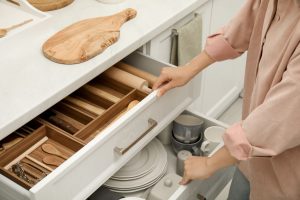Creating a home environment that is both functional and safe for children is essential for any family. In particular, the kitchen and bathroom are two areas where special considerations must be made to ensure they are child-friendly.
These spaces often pose unique challenges, from sharp edges and hot surfaces in the kitchen to slippery floors and hazardous chemicals in the bathroom. By addressing these concerns thoughtfully, you can transform these critical areas into safe and enjoyable spaces for your little ones.
Designing a child-friendly kitchen and bathroom involves more than just childproofing; it requires a balance between safety, accessibility, and engaging design.
This blog will guide you through practical tips and creative ideas to help you make these essential parts of your home both functional and inviting for children.
Whether you’re updating your current space or planning a new one, focusing on these aspects will ensure your kitchen and bathroom cater to your family’s needs.
Safety First
When designing a child-friendly kitchen, safety should be your top priority. A childproofing cabinet is a crucial step; use safety locks to prevent children from accessing harmful substances or sharp utensils.
Opting for induction hobs can enhance safety, as they only heat up when in contact with a pan, reducing the risk of burns. Securing appliances, such as dishwashers and ovens, with safety features or barriers will help protect inquisitive hands from potential harm.
In the bathroom, anti-slip flooring is essential to prevent accidents from slippery surfaces. Installing thermostatic controls on taps and showers ensures that water temperature remains constant and safe, avoiding scalding.
Additionally, securing medicine cabinets with childproof locks keeps potentially dangerous items out of reach. By implementing these safety measures, you can significantly reduce the risk of accidents and create a more secure environment for your children.
Easy Accessibility
Accessibility is a key factor in designing a kitchen where children can safely participate. Lowering countertops can make food preparation and cooking activities more accessible, while step stools allow children to reach higher areas safely.
Organising storage so that children can easily access their plates, cups, and utensils encourages independence and makes mealtime more enjoyable.
In the bathroom, child-height sinks are a great addition to make handwashing and brushing teeth easier for younger children. Providing accessible bath toys and placing towels within easy reach allows children to manage their bath time routines.
These thoughtful adjustments not only make the space more functional but also foster a sense of independence and responsibility in your children.
Durability and Cleanability
Choosing the right materials is crucial for both durability and ease of maintenance in child-friendly kitchens and bathrooms. Opt for stain-resistant surfaces that can withstand the wear and tear of everyday use, including spills and splashes.
Durable worktops and easy-to-clean flooring options will help maintain a hygienic environment and ensure that your space remains in top condition.
Finishes also play a significant role in maintaining a child-friendly environment. Use non-toxic, washable paints for walls to ensure that they are safe for children and can be easily cleaned.
Scratch-resistant worktops are another practical choice, as they are more durable and require less upkeep. By selecting materials and finishes that are both functional and easy to maintain, you can keep your kitchen and bathroom looking fresh and welcoming.
Fun and Engaging Design
A child-friendly kitchen doesn’t have to be bland or uninspiring. Incorporate bright colours and child-friendly utensils to make the space more inviting for children. Interactive learning spaces, such as a small chalkboard or a dedicated area for creative activities, can transform the kitchen into a fun and engaging environment.
By making the kitchen a place where children feel excited and comfortable, you encourage them to participate in family meals and activities.
Similarly, a bathroom can be transformed into a fun space with themed decor and playful accessories. Consider adding vibrant bath mats, colourful shower curtains, or wall decals featuring favourite characters to make bath time more enjoyable.
Fun accessories, like a playful soap dispenser or a set of colourful bath toys, can further enhance the appeal of the bathroom and make it a space that children look forward to using.
Encouraging Independence
Fostering independence in the kitchen involves creating areas where children can safely engage in cooking activities. Designate a child-friendly workstation where they can help with age-appropriate tasks, such as washing vegetables or stirring ingredients.
This not only helps them learn valuable life skills but also makes them feel included in family meal preparations.
In the bathroom, organise the space to support self-care routines. A clear, step-by-step organisation for items such as toothbrushes, hairbrushes, and bathing supplies helps children manage their hygiene routines.
By setting up the bathroom to encourage independence, you empower your children to take responsibility for their care and build confidence in their abilities.
Storage Solutions
Effective storage solutions are essential for maintaining order in a child-friendly kitchen. Use organised drawers and accessible shelves to keep snacks and dishes within easy reach for children. Implementing labelled storage bins can also help children find what they need quickly and encourage them to put things away properly after use.
In the bathroom, thoughtful storage solutions are equally important. Incorporate toy storage solutions, such as bins or shelves, to keep bath toys organised and easily accessible.
Pull-out bins for used towels and conveniently placed hygiene products ensure that everything is within reach and easy to manage.
By designing effective storage solutions, you create a more functional and tidy space that supports both children’s and adults’ needs.
Conclusion
Incorporating child-friendly elements into your kitchen and bathroom design is key to creating a safe, functional, and enjoyable environment for your family.
By focusing on safety, accessibility, durability, and engaging design, you can transform these essential spaces into areas that cater to both children and adults.
The result is a home that not only meets practical needs but also fosters a positive and supportive atmosphere for children.
Balancing these considerations ensures that your kitchen and bathroom are welcoming spaces where children can learn, grow, and thrive.
By carefully planning and implementing child-friendly features, you create an environment that supports your family’s needs while making everyday activities more enjoyable and efficient.




